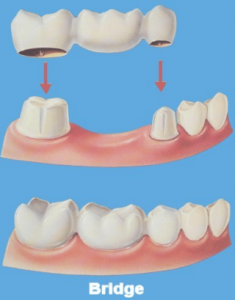08 Apr What is a dental bridge?
A dental bridge is used to close gaps in your smile or mouth caused by missing teeth. It is essentially a false tooth (called a pontic) that is held in place by the teeth on either side of the gap. Bridges are typically made from porcelain to blend in with your natural teeth, although they can be made from a range of materials including metal and gold.
What are the different types of bridges?
There are four types of bridges: traditional, cantilever, Maryland and implant-supported bridges.
Traditional Bridges
Traditional bridges are the most common option and are usually made from zirconia, or porcelain fused to metal. With traditional bridges, a crown is created for the tooth or implant on either side of the gap and the pontic (false tooth) is connected between them. Traditional bridges are used when there are adjacent teeth on both sides of the gap, and ideally those teeth could benefit from having crowns placed on them anyway i.e. have large fillings or similar.
Cantilever Bridges
Cantilever Bridges are used when there is only a single tooth used to support the pontic (false tooth). These can be effective but because they have less support, are generally only successful when used in regions of the mouth that are not under heavy forces.
Maryland Bridges
Also known as resin-bonded bridges, Maryland bridges are either porcelain or porcelain fused to metal. “Wings” extend from one side of the bridge and are bonded to back surface of existing teeth. As with cantilever bridges, these generally are best suited for the front of the mouth, and only when the patient’s “bite”, or occlusion, allow for it.
Implant-Supported Dental Bridge
These use implants rather than crowns or frameworks. In most cases, one implant per missing tooth is inserted and these implants are used to hold the bridge in position. If this arrangement is not possible, then a pontic might be suspended between two implant-supported crowns by the bridge.
How does the process work?
The process of having a dental bridge made and placed happens in three stages: initial consultation, preparation and fitting.
1. Initial Consultation
The process of placing a dental bridge begins with an initial consultation where we will take impressions and measurements of your mouth. This will ensure that your custom-made bridge feels comfortable and fits well.
2. Preparation
To prepare for your dental bridge to be fitted, the two neighbouring teeth on either side of the gap will usually be prepared and a mould or scan to make the bridge will be taken. The mould or scan is sent to our local dental ceramist, who are experts in creating the perfectly custom designed prostheses.
3. Fitting
Once the bridge has been made, you will come in for an appointment to have the bridge fitted. It is put in place and usually cemented to the adjacent teeth. In the case of an implant-supported dental bridge, the bridge will be anchored to the implants.
What do dental bridges help with?
A missing tooth or teeth can have a number of resulting issues that a dental bridge can help to resolve. They will restore your smile along with unimpaired speech and pronunciation. They help with maintaining the shape of your face and prevent remaining teeth from moving out of the correct position. They also effectively assist with re-adjusting your bite so that the force is properly distributed and you are able to chew properly.
What are the downsides of a dental bridge?
Bridges generally require at least one of the teeth on either side of the space to be prepared or filed down to make room for supports of the false tooth. In general we are as minimally invasive as possible and don’t like to “prepare” teeth if we can help it, though when they do need, it we use techniques to be as conservative as possible.
Bridges also require particular hygiene, such as using “superfloss”, which can be trickier than looking after a regular tooth.
Are dental bridges covered by insurance?
This will depend on the type of insurance that you have, and the specific insurer. In Australia, there are two main types of dental insurance: general dental coverage and major dental coverage:
- General coverage usually includes oral hygiene and other basic procedures, and has a waiting period of two months. It will not cover dental implants, crowns and
- Major coverage will usually include procedures such as bridges and crowns. In most cases you will need ‘extras’ coverage for these procedures.



